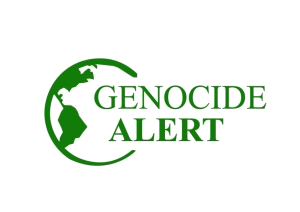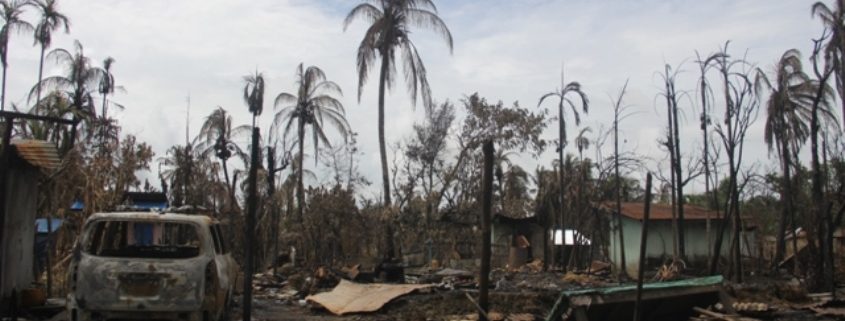The Plight of the Rohingya – Responsibility to prevent ethnic cleansing?
Given the ongoing violence in Myanmar against and forced displacement of the Rohingya, the seeming inability of the international community to either condemn or prevent what arguably could be described as text book ethnic cleansing raises the question of what the responsibility to protect means in practice. The threat to their safety and violation of their human rights, as well as the humanitarian crisis is compounded the historical statelessness and discrimination against the Rohingyas, a Muslim minority from Rakhine state, who will continue to suffer and be subject to more atrocities if the international community continues to do nothing.
The situation of the Rohingya in Rakhine state
Any possible political solutions to the Rohingya crisis in Myanmar require an understanding of the ethnic and cultural divisions, the emergence of the armed terrorist groups, the legal statelessness of the Rohingya minority, their forced displacement as well as the political constraints of the government in conjunction with the primacy of the military. The ongoing violent attacks on the part of the government units as well as the ethnic terror organization ARSA have turned the long-term precarious situation of the Rohingya into a humanitarian crisis, and also have raised the spectre of genocide. How the international community as well as civil society groups and organizations could try to avert further atrocities and prevent an escalation remains contested. Indeed, whether they have an obligation under the R2P to prevent Ethnic Cleansing is itself highly controversial, as some states are contesting the allegations of Ethnic Cleansing.
The Myanmar Army’s campaign of killing, rape and arson in Rakhine has driven more than 600,000 Rohingya out of the country since late August, in what the United Nations says is the fastest displacement of a people since the Rwanda genocide. But in Myanmar, and even in Rakhine itself, there is stark denial that any ethnic cleansing is taking place. The current climate of violence and suffering is exacerbated by the Myanmar government’s refusal to allow full humanitarian access, which only multiplies the suffering of the Rohingya and stokes fears of the resurgence in 2017 of violence amidst accusations against humanitarian workers. Further the geographic isolation and lack of infrastructure, as well as government restrictions make accessing Rakhine state itself incredibly difficult.
Deep rooted ethnic tensions in Myanmar
This denial is fuelled by deep rooted ethnic tension between the Buddhist majority in Myanmar and the dominantly Muslim minority of the Rohingya. The intentional misinformation and allegations coupled with the government’s unwillingness to allow humanitarian access compound the impression of its complicity in the violence being conducted in Rakhine. Against the background of Myanmar’s delicate power sharing, between the fledgling democratically elected government and the military, the refusal to even recognise the Rohingya given the ongoing peace process and attempts to reconcile the long standing ethnic conflicts[i] seems incongruous. Internationally Aung San Suu Kyi risks falling “between two stools — depicted by the military as too weak on ‘national security’ while being seen in the eyes of the international community as too weak in her defense of an ethnic minority.”
Rohingya crisis parallels previous instances of genocide and ethnic cleansing
In Rakhine the Myanmar security forces’ method of achieving these goals has involved terrorising Rohingya out of their homes, mostly through shooting, killing, sexual violence and threats; followed by the burning of their homes and villages, which have now been documented and corroborated. The Rohingya crisis increasingly parallels previous instances of genocide and ethnic cleansing, which also features inaction by UN and the international community, a fledgling democracy as well as an extremist terrorist group.
Ethnic cleansing which is not recognised by the UN as a legally enforceable term, can be defined as an organised deportation operation, aimed to force people through violent and terror inspiring means to leave their homes and to ensure they do not return.
So far, the UN has expressed deep concern and called for immediate steps to end the violence, ensure the protection of civilians and resolve the refugee problem, but does not specifically identify perpetrators. Indeed, the UN has instead called for Myanmar to fulfil its commitments “to provide humanitarian assistance to all displaced individuals.” The Rakhine commission’s report, which tried to take these considerations into account, could provide a roadmap for further action in this crisis. However, the Commission’s work has been hampered by a lack of access and cooperation on the side of the Myanmar government.
A crime against humanity
Arguably under international law these acts could be qualified as a crime against humanity of “deportation or forcible transfer of population, which has clearly been committed by the Myanmar security forces since 25 August. What the obligations of the international community are is contested, as the matter is perceived by some as an internal matter. For example, China, backed by Russia, has blocked a statement by the UN Security Council, which would have “noted with concern renewed fighting in some parts of the country and stressed the importance of humanitarian access to all affected areas.” Without Security Council consensus, there is little hope for negotiation of a better deal for the Rohingya. Existing proposals for Weapons embargos or Security Council resolutions cannot pass without Chinese and Russian assent. Even the Rakhine commission report’s practical short -term suggestions are unlikely to be implemented and if they were, the underlying causes of tension and violence are not addressed, meaning even those will not be able to adequately hope to stabilise the situation. Further the largest regional organisation, ASEAN, continues to follow its non-intervention doctrine, and therefore will not exert pressure on Myanmar, as seen in the Chairman’s statement of this year’s ASEAN summit.
International refugee protections extend to those Rohingya who have crossed into Bangladesh, and fall under the Geneva conventions. The Universal Declaration of Human Rights, Article 14(1) sets out that “everyone has the right to seek and to enjoy in other countries asylum from persecution.” Myanmar’s forces are committing a host of human rights violations as prohibited in the International Covenant on Economic, Social and Cultural Rights, which Myanmar ratified in early October, even as its soldiers continued to burn Rohingya homes. However no international legal foundation has emerged, given that the majority of legal mechanism would require Myanmar’s consent, which it is unlikely to give. A possible path to intervention by the International Criminal Court could be envisioned, if Bangladesh were to bring a case, arguing of the influx of Rohingya fleeing the ethnic violence as undermining its right to internal matters (sovereignty).
Crucially there can be ‘no peace without repatriation’, which is made almost impossible given the 1982 Citizenship Law which has actually created the world’s largest population of stateless people in a given country. It is this underlying lack of legal recognition and protection within Myanmar make the Rohingya vulnerable to Human Rights abuse, in addition to being displaced due to the violence directed against them. Further the dispute between Bangladesh and Myanmar over their ethnic origin makes the dispute over their right return even more intractable. Whether a recent agreement between Bangladesh and Myanmar over the return of refugees will be implemented remains an open question, as there are concerns that Myanmar’s army obstruct the deal. The internal division between the Muslim minority Rohingya and the majority Buddhist Burmese is not a new divide, but rooted in a history of discrimination and ethnic tension.
No simple solutions for Myanmar
The international community’s Responsibility to Protect as well as the United Nations mandate to prevent the conflict from destabilising the region is in stark contrast to the ongoing atrocities being allowed to continue and further threaten to repeat the mistakes of the past. There are no simple solutions for Myanmar however inaction on the part of the international community will not resolve anything. One possible path forward, beyond condemnation alone, would be to impose a comprehensive arms embargo on Myanmar, which would reduce the risk of escalation and send a clear signal to those responsible, without affecting the civilian population.
All solutions will unfortunately ultimately come down to the political will to resolve this issue and tackle the root causes of this crisis. The international community must do more to address the crimes against humanity and ongoing ethnic cleansing against the Rohingya civilian population in Myanmar, as well as push for dialogue and a halt to the ongoing violence.
__________________________
[i] These include 23 conflicts and many armed militias which have shaped the delicate internal situation of Myanmar
Autor: Robert Menzies, Genocide Alert

